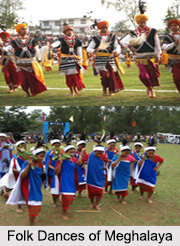 Folk Dances of Meghalaya forms an integral part of the culture of Meghalaya. Meghalaya is the home of music and dances. The dances are associated with their festivals or seasons and hence are to be enjoyed throughout the year. The tribal dances are performed at events like social, religious, agricultural, funeral and recreational. All the tribes have their own identity and separate dance forms associated with different occasions. The land echoes the sound of perfect tempo, beautiful songs and traditional instruments. They also have their own musical instruments consisting of various kinds of drums, harps, pipes and flutes.
Folk Dances of Meghalaya forms an integral part of the culture of Meghalaya. Meghalaya is the home of music and dances. The dances are associated with their festivals or seasons and hence are to be enjoyed throughout the year. The tribal dances are performed at events like social, religious, agricultural, funeral and recreational. All the tribes have their own identity and separate dance forms associated with different occasions. The land echoes the sound of perfect tempo, beautiful songs and traditional instruments. They also have their own musical instruments consisting of various kinds of drums, harps, pipes and flutes.
Folk Dances of Meghalaya are held at an open ground under the open sky or at public places. The famous Folk Dances of Meghalaya are as follows:
Nongkrem Dance
Nongkrem Dance is a religious festival in thanksgiving to God Almighty for good harvest, peace and prosperity of the community. It is held annually during October-November, at Smit, the capital of the Khyrim Syiemship near Shillong. Unmarried girls decked with gorgeous attire, gold and silver ornaments, and yellow flowers, dance forward and backward forming a circle. Men also dance in a wide circle with a sword and a white hair whisk in their hands.
Shad Suk Mynsiem
Shad Suk Mynsiem is an annual spring dance that celebrates the harvesting and sowing seasons. This dance is performed to celebrate the agricultural cycles. The performers of the dance are girls and boys who wear colourful clothes and jewellery, which is accompanied by drums and pipes called "Tangmuri", the queen of musical instruments. However, only unmarried-virgin girls are allowed to perform this dance. This is a colourful thanksgiving festival celebrated during the spring season all over Khasi Hills.
Behdienkhlam
Behdienkhlam is a Dance festival celebrated annually in the monsoon season in the month of July after the sowing period. It is the most popular tribal dance festival of the Jaintias. The festival primarily invokes the blessings of the Creator for a good harvest and to drive away disease and plague.
Wangala Dance
Wangala Dance is basically a part of the Wangala Festival. This is a major festival of the Garos, celebrated during autumn, after the harvesting season. The festival includes propitiation ceremonies to the deity "Patigipa Rarongipa", held in every village. The four days and nights of the festival are accompanied by dancing and merriment. It culminates in the warrior`s dance – the "Dance of a Hundred Drums", on the final day which is a spectacular sight.
Dorsegata Dance
Dorsegata Dance festival is another dance in which, while dancing the women try to knock off the turbans of their male partners. If the women succeed, it is followed by peals of laughter.
Lahoo Dance
Lahoo Dance forms a part of the Behdienkhlam festival. The Lahoo Dance is performed by both male and female for entertainment. Men and women dressed in colourful garments take active part in the dance form. This dance form is performed by a girl, linking arms with two boys on either side. It is remarkable that, instead of any musical instruments, a man with a natural talent in recitation recites couplets during the dance performances.



















